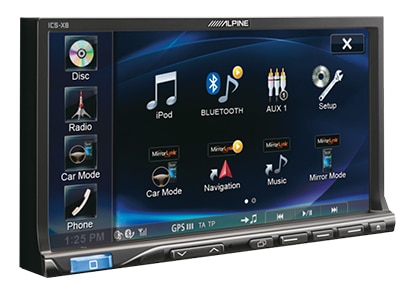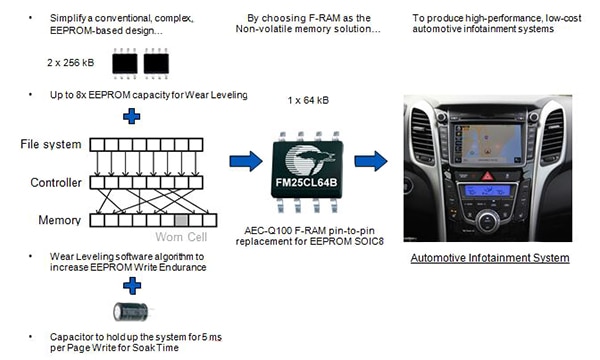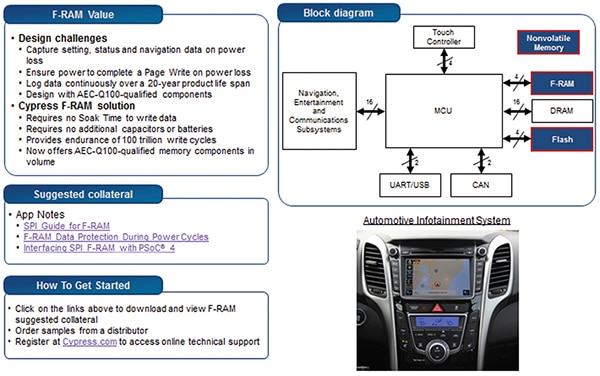Cypress F-RAM for Automotive Infotainment
Contributed By DigiKey
2015-08-05
Demand for new features is driving fast automotive infotainment growth. Nine million automotive infotainment systems were produced in 201; and annual production is expected to grow quickly to 60 million by 2019. Automotive infotainment systems (as illustrated in Figure 1) offer new features such as real-time local traffic and retail information, radar-based parking assist and safety systems, independent rear-passenger audio/video, wireless internet, and adaptive voice control. These new features require additional high-performance, high-reliability non-volatile memories. EEPROM cannot meet these requirements without increasing design costs. Automotive infotainment systems require high-performance, high-reliability, low-cost non-volatile memories.

Figure 1: Automotive infotainment system.
Common design problems engineers face include:
- Automotive infotainment systems must store settings, status, and navigation data on power loss.
- The Soak Time for EEPROMs requires 5 ms of active power per Page Write.
- The Soak Time requires additional capacitors or batteries to perform a Page Write on power loss, increasing system cost.
- Automotive infotainment systems exceed the 1-million-cycle Write Endurance limitation of EEPROMs.
- Wear leveling is required to improve EEPROM Write Endurance to support a 20-year automotive lifetime requirement.
- Wear leveling requires up to 8x the memory capacity and additional software, thus, increasing system cost.
- Automotive manufacturers require AEC-Q100-qualified non-volatile memories.
Cypress's F-RAM solves these problems. F-RAM requires no Soak Time, eliminating the need for additional capacitors or batteries to complete a Page Write on power loss. It also provides 100 trillion write cycles, eliminating the need for Wear Leveling. Cypress now offers AEC-Q100-qualified memories in volume. Therefore, Cypress F-RAM is a high-performance, high-reliability, low-cost replacement for EEPROMs in a fast-growing market.
As mentioned above, a conventional EEPROM design requires up to 8x more EEPROM capacity, wear-leveling software to increase endurance, and a capacitor to hold up the system for the 5 ms per Page Write for Soak Time. As shown in Figure 2, this complex EEPROM base design can be simplified by choosing F-RAM as the nonvolatile memory solution to produce a high-performance, low-cost automotive infotainment system. To get started, the designer should select an F-RAM serial memory from the F-RAM Product Selector Table available on the Cypress website, Cypress.com. They can click Order to request free samples. The user can also watch a Demo Video and register on cypress.com to gain access to online technical support.

Figure 2: Complex EEPROM solution vs. F-RAM solution.
An example of designing an automotive infotainment system with F-RAM can be seen in Figure 3. In this example, F-RAM is used for storing audio, radio, Bluetooth, and climate control settings along with GPS coordinates and GPS calibration data. F-RAM simplifies the design by eliminating the need for Wear Leveling firmware and Soak Time capacitors. It also replaces multiple EEPROMs with a single EEPROM solution. Serial F-RAM is available in various options including densities ranging from 4 kB to 2 Mb, and voltages of 2 - 5.5 V. It has two different interface options, SPI and I2C, and three different package types; SOIC8, DFN8, and EIAJ8. It is also qualified to AEC-Q100 Grades 1 and 3. As can be seen, Cypress F-RAM offers a simple, reliable, fast, and high-endurance nonvolatile memory solution.

Figure 3: Infotainment system with F-RAM example.
In summary, F-RAM requires no Soak Time, eliminating the need for additional capacitors or batteries to complete a Page Write on power loss. It provides 100 trillion write cycles, eliminating the need for Wear Leveling, and is available in AEC-Q100-qualified memories in volume. Cypress F-RAM is a high-performance, high-reliability, low-cost replacement for EEPROMs in a fast-growing market. To get started, the designer can take a look at the detailed application notes and register on Cypress.com to get access to online technical support.
References
- For a full audio version of this training please visit: F-RAM for Automotive Infotainment

Disclaimer: The opinions, beliefs, and viewpoints expressed by the various authors and/or forum participants on this website do not necessarily reflect the opinions, beliefs, and viewpoints of DigiKey or official policies of DigiKey.









